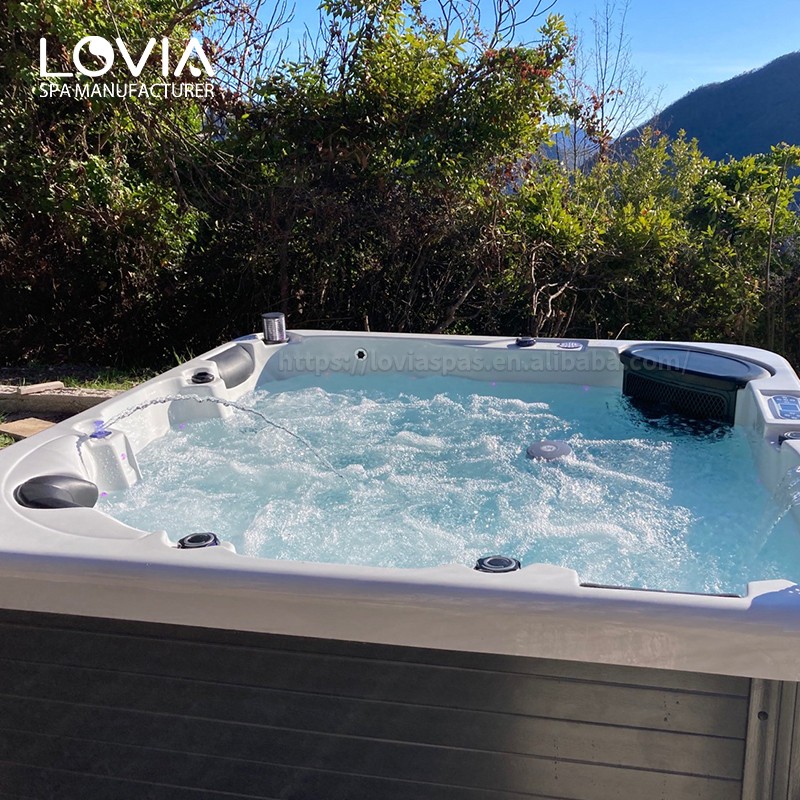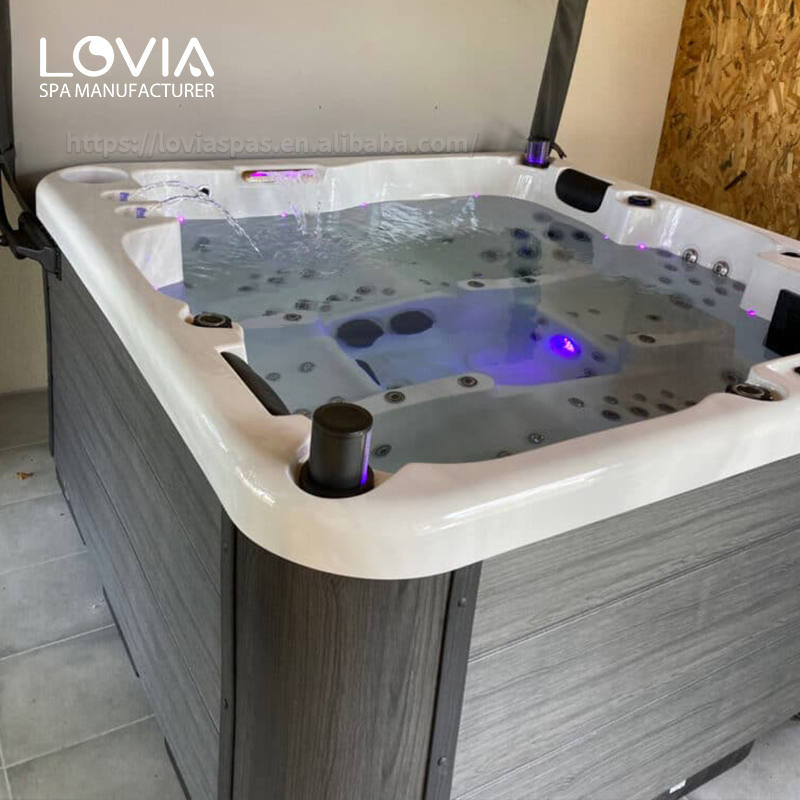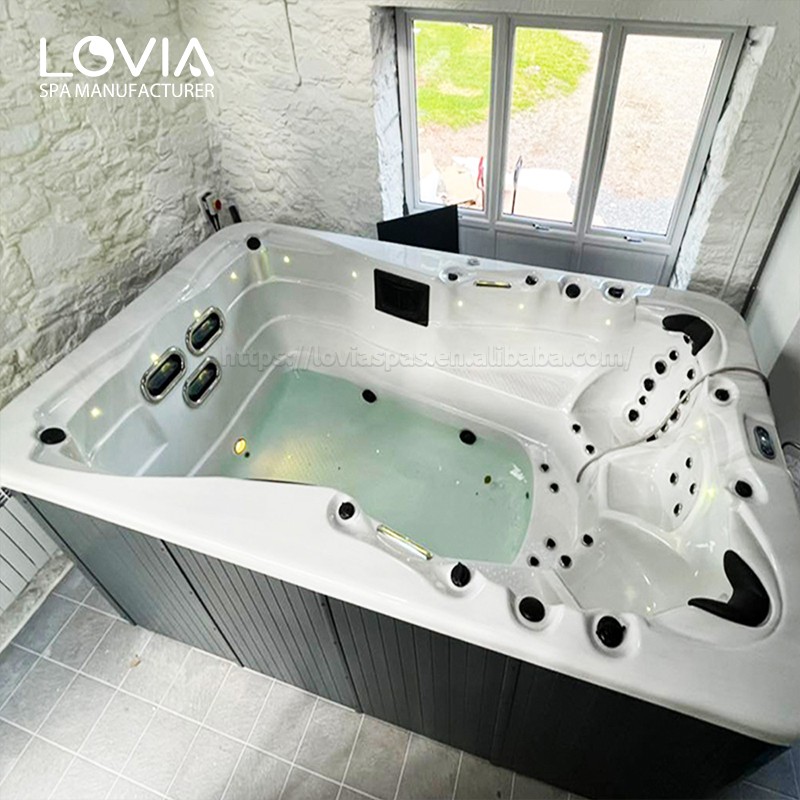
Does shock lower the pH value in an outdoor jacuzzi bathtub?
2025-04-19 15:30As a device that combines relaxation and physiotherapy functions, the outdoor jacuzzi bathtub has become increasingly popular in recent years. During use, maintaining the balance of water quality in the outdoor jacuzzi bathtub is the key to ensuring its effective use and healthy experience, and the pH value is one of the core indicators of water quality management. The correct pH balance not only ensures clear water quality and normal operation of the equipment, but also reduces skin irritation and the use of chemicals.
In the process of water quality management, "shock treatment" is a common method to remove impurities and pollutants in the water and restore the cleanliness of the water. However, does shock treatment affect the pH value in the water? Many users of outdoor jacuzzi bathtubs are confused about this. This article will analyze in detail the principle of shock treatment and its impact on pH value, explore how to effectively manage water quality, and answer whether shock treatment will lower the pH value in the outdoor jacuzzi bathtub.

What is pH value and its importance in water quality management?
The pH value is a measure of the concentration of hydrogen ions in water, which indicates the acidity or alkalinity of the water, ranging from 0 to 14, with 7 being neutral. A pH value below 7 indicates that the water is acidic, while a pH value above 7 indicates that the water is alkaline. In an outdoor jacuzzi bathtub, the ideal pH value is usually between 7.2 and 7.8. Water quality in this range is gentle on human skin and eyes, and can effectively maintain the activity of chemical disinfectants and prevent corrosion or mineral deposits on bathtub parts.
Too high or too low pH values in outdoor jacuzzi bathtub water can cause a series of problems. Too low pH values, that is, acidic water quality, can easily corrode metal parts, damage the internal system of the bathtub, and irritate the skin and eyes. On the other hand, too high pH values, that is, alkaline water quality, can cause disinfectants to be ineffective, the water body to be turbid, and cause mineral precipitation, such as the accumulation of calcium or magnesium. Therefore, maintaining a balanced pH value is essential for the normal operation of an outdoor jacuzzi bathtub.

What is shock treatment?
Shock treatment, also known as "water treatment shock" or "super chlorination", refers to the process of adding a large amount of oxidants (such as chlorine or bromine) to the water of an outdoor jacuzzi bathtub to remove organic pollutants, microorganisms and other impurities in the water. The main purpose of shock treatment is to quickly eliminate byproducts such as chloramines and bromines in the water body, improve the cleanliness and transparency of the water body, and ensure the health of the water quality.
In an outdoor jacuzzi bathtub, due to the high water temperature, the water body is more susceptible to microbial contamination, such as the growth of bacteria, algae and fungi. In addition, human sweat, oil, cosmetics and impurities in the environment (such as dust and pollen) will also enter the water, increasing the organic pollutants in the water body. These pollutants will not only cause the water quality to deteriorate, but may also cause the disinfectant to fail. Therefore, regular shock treatment is an important means to maintain water quality.
When shocking the outdoor jacuzzi bathtub, commonly used oxidants include chlorinating agents (such as hydrogen peroxide, sodium dichloroisocyanurate) or chlorine-free oxidants (such as potassium persulfate). These chemicals react quickly with impurities in the water, breaking them down into harmless forms and reactivating the disinfectant's ability to kill bacteria.

How does shock treatment affect the pH of your outdoor jacuzzi bathtub?
Although shock treatment is effective in purifying water and improving the sanitation of your outdoor jacuzzi bathtub, it does have some effect on the pH of the water. Whether shock treatment lowers the pH depends on the type and dosage of shock agent used and the original water quality. The following is a detailed discussion of the effects of several common shock agents on pH.
Effects of Chlorine-Based Shock Agents on pH:
Common chlorine-based shock agents include sodium hypochlorite (liquid chlorine) and sodium dichloroisocyanurate (dry powder chlorine). These shock agents decompose in water to produce hypochlorous acid and hypochlorite ions, which are highly oxidizing and can quickly kill microorganisms and organic matter. However, sodium hypochlorite itself is alkaline and will raise the pH of your outdoor jacuzzi bathtub water when added to water. Therefore, the pH tends to rise slightly when chlorine-based shock agents are used.
However, it should be noted that the oxidation reaction of chlorine produces chloramine as a byproduct. Chloramine is acidic and its long-term presence in water may cause the pH value to drop. Therefore, although chlorine-based shock agents will increase the pH value in the short term, if used improperly for a long time, the accumulation of acidic byproducts in the outdoor jacuzzi bathtub water may cause the pH value to gradually decrease.
Effect of chlorine-free shock agents on pH value:
In recent years, many outdoor jacuzzi bathtub users have begun to use chlorine-free shock agents, such as potassium persulfate or hydrogen peroxide. The benefit of these oxidants is that they do not produce chloramines or other byproducts when reacting in water, so the effect on pH value is relatively neutral.
Potassium persulfate is a commonly used chlorine-free shock agent, and its reaction in water does not usually significantly change the pH value. However, excessive use may cause a short-term acidic environment, causing the pH value to drop slightly. Therefore, when using chlorine-free shock agents, special attention should be paid to the dosage to ensure that it is within a reasonable range.
What are the reasons for pH fluctuations after shock treatment?
The pH change after shock treatment is not only related to the type of chemical used, but also closely related to other factors. For example, the total alkalinity in the outdoor jacuzzi bathtub, the water temperature, the concentration of organic pollutants, etc. can affect the fluctuation of pH. Here are some common influencing factors:
Total alkalinity:
Total alkalinity is the sum of substances such as carbonates, bicarbonates and hydroxides in the water. It buffers the changes in pH to a certain extent. The higher the total alkalinity, the more stable the pH is and it is not easily affected by chemical treatment. If the total alkalinity in the outdoor jacuzzi bathtub is low, the pH fluctuation during shock treatment will be larger, which may cause the pH to drop or rise rapidly.
Water temperature:
The chemical reaction rate of water quality in high temperature environment is faster, so the chemical changes in outdoor jacuzzi bathtub will be more drastic than those in normal temperature water pool. At high temperature, the effect of shock treatment is faster and more significant, but it also means that the fluctuation of pH value may be more obvious. The higher the temperature, the more active the chemical reaction in the water, and the faster the pH value changes.
Concentration of organic pollutants:
The main purpose of shock treatment is to remove organic pollutants from water. When a large amount of organic matter (such as body oils, cosmetics, and dirt) accumulates in the outdoor jacuzzi bathtub, the shock agent will quickly react with these pollutants to produce acidic byproducts. If the concentration of organic matter is high, the byproducts produced by the reaction may significantly reduce the pH value in the water. Therefore, the concentration of pollutants in the water quality will also directly affect the change in pH value after shock treatment.
Dosage of shock agent:
The dosage of outdoor jacuzzi bathtub shock treatment is crucial. Excessive chemical agents will not only affect water quality, but may also cause significant changes in pH value. If the dosage of shock agent is too large, the oxidation reaction in the water will be too strong, which may cause byproduct accumulation and significantly reduce pH value. Conversely, insufficient dosage may not effectively remove organic pollutants, resulting in the inability to completely purify the outdoor jacuzzi bathtub water quality.

How to maintain pH balance after shock treatment?
In order to avoid excessive impact on pH value during outdoor jacuzzi bathtub shock treatment, users need to take appropriate measures to maintain water quality balance. Here are some tips for maintaining pH balance after shock treatment:
Test your outdoor jacuzzi bathtub water regularly:
After shock treatment, you should immediately test the pH and total alkalinity in your outdoor jacuzzi bathtub water. There are a variety of simple water quality test kits on the market that can accurately measure the chemical indicators in the water. If you find that the pH value fluctuates significantly, you should take timely measures to adjust it.
Use pH adjusters:
If the outdoor jacuzzi bathtub shock treatment causes the pH value to drop too much, you can use pH increasers (such as sodium carbonate) to raise the pH value of the water; if the pH value is too high, you can use pH reducers (such as sulfur dioxide or phosphates). These chemicals can help quickly restore the acid-base balance in the water to ensure that the water quality of the bathtub is within a safe range.
Control the amount of shock agent:
When shocking your outdoor jacuzzi bathtub, strictly follow the dosage recommendations on the product manual to avoid overdosing. Excessive shock agents are not only wasteful, but may also cause water quality imbalances and cause trouble for subsequent maintenance work. Generally, regular small-dose shocks are more effective and safer than occasional large-dose treatments.
Keep total alkalinity within a reasonable range:
When total alkalinity is between 80 and 120 ppm, the pH is relatively stable. If total alkalinity is too low, the pH of the outdoor jacuzzi bathtub water will be more susceptible to external factors, so the total alkalinity needs to be checked and adjusted regularly. If the total alkalinity is found to be too low, an alkalinity enhancer (such as sodium bicarbonate) can be used to increase the alkalinity and stabilize the pH.
What is the lead time for receiving my spa order?
At Lovia Spa, we pride ourselves on efficient production and delivery timelines. With over 1,200 spas produced monthly at our 45,000-square-meter factory, we can fulfill most orders within 4-6 weeks, depending on the customization requirements. For wholesale orders, we also offer expedited shipping to meet your business’s deadlines.
